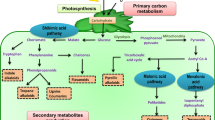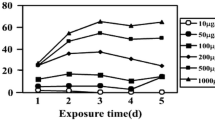Abstract
Penicillium thomii PT95 strain was able to form abundant orange, sand-shaped sclerotia in which carotenoids were accumulated. The aim of this work was to determine the effects of copper-induced oxidative stress on the sclerotial differentiation and antioxidant properties of PT95 strain. The results showed that the time of exudates initiation, sclerotial initiation and sclerotial maturation of PT95 strain were advanced in 1–2 days under the copper-induced oxidative stress growth conditions. The analytical results of sclerotial biomass, carotenoids content in sclerotia showed that copper-induced oxidative stress favored the sclerotial differentiation and biosynthesis of carotenoids. Under the copper-induced oxidative stress growth conditions, the total phenolics content and DPPH free radical scavenging activity of sclerotia of this fungus were decreased as compared with the control. However, the oxidative stress induced by a lower amount of CuSO4 in media could enhance significantly the reducing power of sclerotia.




Similar content being viewed by others
References
An GH, Schuman DB, Johnson EA (1989) Isolation of Phaffia rhodozyma mutants with increased astaxanthin content. Appl Environ Microbiol 55:116–124
Burton WG, Ingold UK (1984) β-Carotene: an unusual type of lipid antioxidant. Science 224:569–573
Cuyers AJ, Vangronsveld H, Clijsters WC (2000) Biphasic effect of copper on the ascorbate glutathione pathway in primary leaves of Phaseolus vulgaris seedlings during the early stages of metal assimilation. Physiol Plant 110:512–517
Espín JC, García-Conesa MT, Tomás-Barberán FA (2007) Nutraceuticals: facts and fiction. Phytochemistry 68:2986–3008
Evans JD, Aronstein K, Chen YP et al (2006) Immune pathways and bees mechanisms in honey bees Apis mellifera. Insect Mol Biol 15:645–656
Fernandes JC, Henrique FS (1991) Biochemical, physiological and structural effects of excess copper in plants. Bot Rev 57:246–273
Finkel T (2003) Oxidant signals and oxidative stress. Curr Opin Cell Biol 15:247–254
Georgiou CD (1997) Lipid peroxidation in Sclerotium rolfsii: a new look into the mechanism of sclerotial biogenesis in fungi. Mycol Res 101:460–464
Georgiou CD, Tairis N, Polycratis A (2001) Production of β-carotene by Sclerotinia sclerotiorum and its role in sclerotium differentiation. Mycol Res 105:1110–1115
Georgiou CD, Patsoukis N, Papapostolou I et al (2006) Sclerotial metamorphosis in filamentous fungi is induced by oxidative stress. Integr Comp Biol 46:691–712
Gessler NN, Aver’yanov AA, Belozerskaya TA (2007) Reactive oxygen species in regulation of fungal development. Biochemistry (Moscow) 72:1091–1109
Han JR (1998) Sclerotia growth and carotenoid production of Penicillium sp. PT95 during solid-state fermentation of corn meal. Biotechnol Lett 20:1063–1065
Han JR, Wang XJ, Yuan XE (1998) Studies on the production of carotenoids in sclerotia of PT95 strain of Penicillium. Microbiology 25:319–321
Han JR, Zhao WJ, Gao YY et al (2005) Effect of oxidative stress and exogenous β-carotene on sclerotial differentiation and carotenoid yield of Penicillium sp. PT95. Lett Appl Microbiol 40:412–417
Kiritsakis K, Kontominas MG, Kontogiorgis C et al (2010) Composition and antioxidant activity of olive leaf extracts from Greek olive cultivars. AOCS 87:369–376
Kuda T, Tsunekawa M, Goto H et al (2005) Antioxidant properties of four edible algae harvested in the Noto Peninsula. Japan J Food Compost Anal 18:625–633
Lee YL, Ming-Tsung Y, Mau JL (2007) Antioxidant properties of various extracts from Hypsizigus marmoreus. Food Chem 104:1–9
Li XL, Cui XH, Han JR (2006) Sclerotial biomass and carotenoid yield of Penicillium sp. PT95 under oxidative growth conditions and in the presence of antioxidant ascorbic acid. J Appl Microbiol 101:725–731
Li HY, Hao ZB, Wang XL et al (2009) Antioxidant activities of extracts and fractions from Lysimachia foenum-graecum Hance. Bioresour Technol 100:970–974
Martins LL, Mourato MP (2006) Effect of excess copper on tomato plants: growth parameters, enzyme activities, chlorophyll, and mineral content. J Plant Nutr 29:2179–2198
McDonald S, Prenzler PD, Autolovich M et al (2001) Phenolic content and antioxidant activity of olive extracts. Food Chem 73:73–84
Murphy A, Taiz L (1997) Correlation between potassium efflux and copper sensitivity in ten Arabidopsis ecotypes. New Phytol 136:211–222
Patsikka E, Kairavuo M, Sersen F et al (2002) Excess copper predisposes photosystem II to photo inhibition in vivo by out competing iron and causing decrease in leaf chlorophyll. Plant Physiol 129:1359–1367
Pitt JI (2000) A laboratory guide to common Penicillium species. Division of Food Processing, North Ryde
Ray AA (1985) SAS users guide: statistics. SAS Institute, Cary, NC
Shimada K, Fujikawa K, Yahara K et al (1992) Antioxidative properties of xanthan on the autoxidation of soybean oil in cyclodextrin emulsion. J Agric Food Chem 40:945–948
Simic GM (1992) Carotenoid free radicals. In: Packer L (ed) Methods in enzymology. Academic Press, New York, pp 444–453
Smeets K, Cuypers A, Lambrechts A et al (2005) Induction of oxidative stress and antioxidative mechanisms in Phaseolus vulgaris after Cd application. Plant Physiol Biochem 43:437–444
Soares JR, Dinis TCP, Cunha AP et al (1997) Antioxidant activities of some extracts of Thymus zygis. Free Radic Res 26:469–478
Stratton PS, Liebler CD (1997) Determination of singlet oxygen-specific versus radical-mediated lipid peroxidation in photosensitized oxidation of lipid bilayers: effect of β-carotene and α-tocopherol. Biochemistry 36:12911–12920
Tsuda M, Ootaka R, Ohkura C et al (2010) Loss of Trx-2enhances oxidative stress-dependent phenotypes in Drosophila. FEBS Lett 584:3398–3401
Veluchamy S, Williams B, Kim K et al (2012) The CuZn superoxide dismutase from Sclerotinia sclerotiorum is involved with oxidative stress tolerance, virulence, and oxalate production. PMPP 78:14–23
Wanita A, Lorenz K (1996) Antioxidant potential of 5-n-pentadecylresorcinol. J Food Process Preserv 20:417–429
White TJ, Bruns TD, Lee S et al (1990) Amplification and direct sequencing of fungal ribosomal RNA genes for phylogenetics. In: Innis MA, Gelfand DH, Sninsky JJ et al (eds) PCR protocols: a guide to methods and applications. Academic Press, New York, pp 315–322
Yruela I (2005) Copper in plants. Braz J Plant Physiol 17:145–156
Acknowledgments
Support for this research by the Chinese National Natural Science Fund (Grant No. 31070048) is gratefully acknowledged.
Author information
Authors and Affiliations
Corresponding author
Rights and permissions
About this article
Cite this article
Zhang, ZQ., Zhao, WJ., Long, DD. et al. Effect of copper-induced oxidative stress on sclerotial differentiation and antioxidant properties of Penicillium thomii PT95 strain. World J Microbiol Biotechnol 30, 1519–1525 (2014). https://doi.org/10.1007/s11274-013-1572-1
Received:
Accepted:
Published:
Issue Date:
DOI: https://doi.org/10.1007/s11274-013-1572-1




